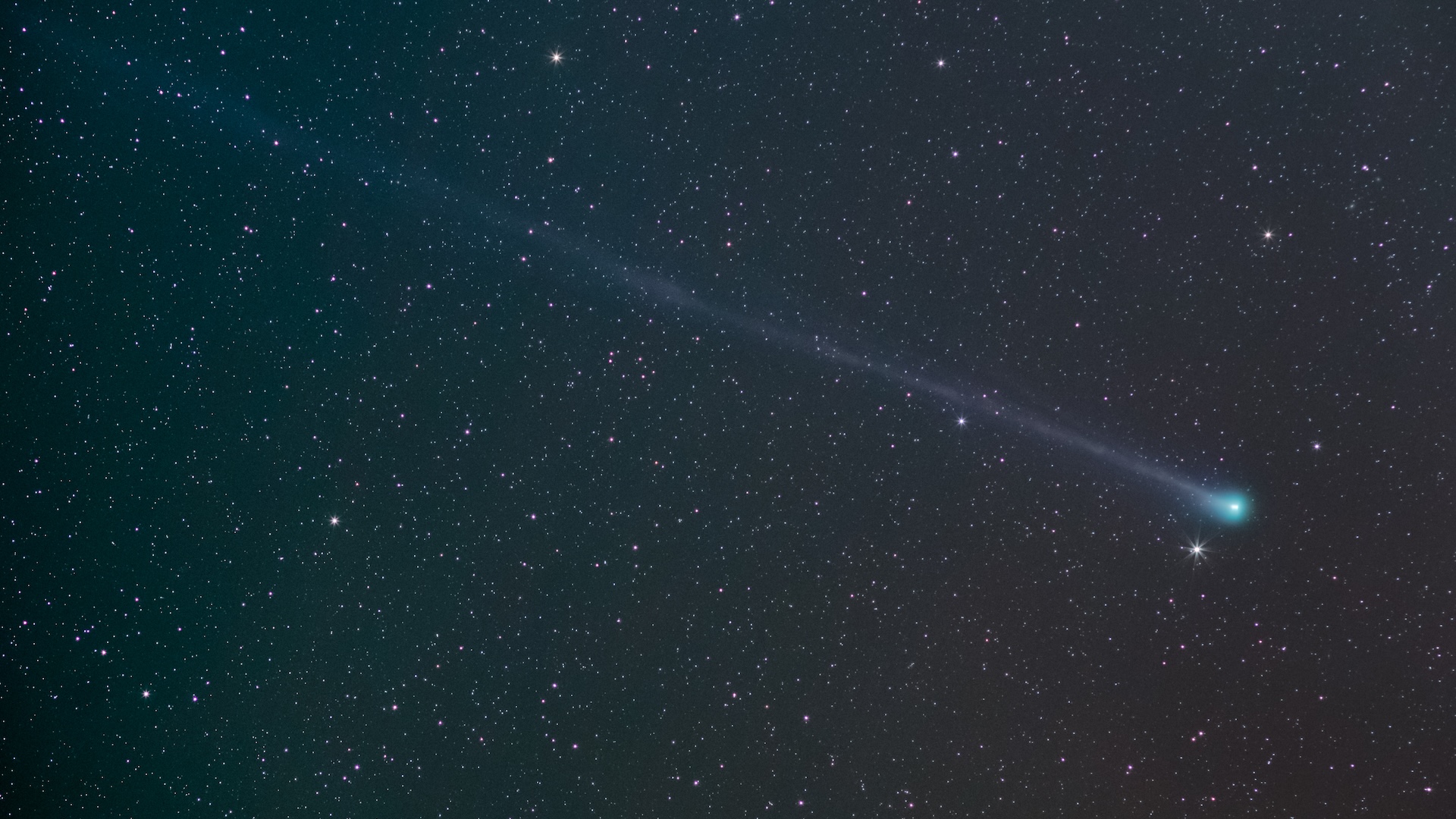By Jamie Carter
Copyright livescience

Skip to main content
Close main menu
Live Science
Sign up to our newsletter
View Profile
Search Live Science
Planet Earth
Archaeology
Physics & Math
Human Behavior
Science news
Life’s Little Mysteries
Science quizzes
Newsletters
Story archive
Lab brains could become conscious
Skyscraper-sized asteroid flyby
Mysterious hand positions on Maya alter
It’s too late to stop AI, readers say
Anthropologist Ella Al-Shamahi on human origins
Don’t miss these
Moon, Mars, and meteors: Why July 28 is the best night for skywatching all summer
2 meteor showers to peak on the same night. Here’s how to catch them at their best.
Perseid meteor shower 2025: How to see ‘shooting stars’ despite the full moon
The Perseids are about to peak — here’s how to watch the glorious meteor shower without the full moon ruining the show
Interstellar comet 3I/ATLAS transforms into a giant ‘cosmic rainbow’ in trippy new telescope image
Nine best things to see in the night sky with binoculars: August to November 2025
Watch newly discovered ‘interstellar visitor’ 3I/ATLAS shoot toward us in first livestream
I watched scientists view the interstellar comet 3I/ATLAS in real time. Here’s what they saw.
New photos of comet 3I/ATLAS reveal its tail growing before our eyes
The full ‘Sturgeon Moon’ rises this weekend
2 ‘new stars’ have exploded into the night sky at once — potentially for the first time in history
Astronomers are racing to study our solar system’s newest ‘interstellar visitor.’ Here’s why.
NASA confirms that mysterious object shooting through the solar system is an ‘interstellar visitor’ — and it has a new name
Interstellar comet 3I/ATLAS could be turning bright green, surprising new photos reveal
See the final ‘planet parade’ of 2025, starting this weekend
Skywatching alert! See 2 bright comets on the same night as a meteor shower this October
Jamie Carter
19 September 2025
Comet C/2025 R2 (SWAN) can now be seen with binoculars close to Mars in the western sky after sunset.
When you purchase through links on our site, we may earn an affiliate commission. Here’s how it works.
Comet SWAN C/2020 F8, a comet from 2020 found by NASA’s Solar Wind Anisotropies (SWAN) instrument.
(Image credit: Chasing Light – Photography by James Stone james-stone.com via Getty Images)
A long-tailed comet has been spotted close to the sun, and some astronomers are predicting it could be seen with the naked eye in mid-October — just as another comet is forecast to do the same. It could mean two bright comets will be visible in the night sky at the same time, on the peak night of a meteor shower.
Comet C/2025 R2 (SWAN), or SWAN R2 for short, was discovered on Sept. 12 by NASA’s orbiting Solar Dynamics Observatory, whose Solar Wind Anisotropies (SWAN) instrument is used to find comets close to the sun. The previously unknown comet was found in SWAN’s images by Vladimir Bezugly, a Ukrainian amateur astronomer, according to Universe Today, and it was initially called SWAN25B. Three days later, the International Astronomical Union’s Minor Planet Center classified the object as a comet and renamed it C/2025 R2 (SWAN).
This long-period comet appears to orbit the sun every 22,554 years, according to EarthSky, and its tail is about the same length as five full moons.
You may like
Moon, Mars, and meteors: Why July 28 is the best night for skywatching all summer
2 meteor showers to peak on the same night. Here’s how to catch them at their best.
Perseid meteor shower 2025: How to see ‘shooting stars’ despite the full moon
Although SWAN R2 is still very close to the sun — passing close to Mars just after dusk, and best seen from the Southern Hemisphere, for now — that’s set to change on Oct. 21, when SWAN R2 will be only 0.27 astronomical units (AU) from Earth, according to The Sky Live. That’s about one-quarter the distance from Earth to the sun.
At that time, the comet could get as bright as magnitude 4, potentially making it visible to the naked eye in dark skies, even in the Northern Hemisphere. Earth may even pass through debris from the comet around Oct. 4-6, which could potentially cause a unique meteor shower. Even if it doesn’t brighten sufficiently to be seen with the unaided eye, the comet should be easily visible through a pair of stargazing binoculars or a good backyard telescope.
What to view them with:
(Image credit: Nikon)
If you want a closer look at the comets, a pair of 10×42 binoculars, like the Nikon Prostaff P7 10×42 (which we gave nearly full marks in our review), will give you fantastic handheld views without too much magnification. Alternatively, compact telescopes are easy to set up and don’t take up too much space in your backyard.
This comet has come to light just as another comet is brightening. Discovered in January by the Mount Lemmon Survey in Arizona, Comet C/2025 A6 (Lemmon) will get closest to Earth on Oct. 21 — the same day as SWAN R2’s closest approach. Comet Lemmon will be about 0.60 AU from Earth and will be visible in the morning and evening. According to Space.com, Lemmon could also get as bright as magnitude 4, which would make it possible to see with the naked eye in a dark sky.
The best nights to see both comets — if they survive their increasingly close approaches to the sun, which is not guaranteed, and they brighten as predicted — will be Oct. 20-23, when they are closest to Earth. Oct. 21 is the date of the new moon, when night skies will be free of moonlight. Oct. 20-21 is also the peak of the Orionid meteor shower, when about 20 “shooting stars” per hour are expected. You won’t want to miss the prospect of two bright comets and meteors in a dark sky.
Sign up for the Live Science daily newsletter now
Get the world’s most fascinating discoveries delivered straight to your inbox.
Contact me with news and offers from other Future brandsReceive email from us on behalf of our trusted partners or sponsorsBy submitting your information you agree to the Terms & Conditions and Privacy Policy and are aged 16 or over.
The last bright comet that was visible to the naked eye was C/2020 F3 (NEOWISE), in summer 2020, although in October 2024, Comet C/2023 A3 (Tsuchinshan-ATLAS) became visible through binoculars during a close approach to Earth.
Jamie Carter
Social Links Navigation
Live Science contributor
Jamie Carter is a freelance journalist and regular Live Science contributor based in Cardiff, U.K. He is the author of A Stargazing Program For Beginners and lectures on astronomy and the natural world. Jamie regularly writes for Space.com, TechRadar.com, Forbes Science, BBC Wildlife magazine and Scientific American, and many others. He edits WhenIsTheNextEclipse.com.
You must confirm your public display name before commenting
Please logout and then login again, you will then be prompted to enter your display name.
Moon, Mars, and meteors: Why July 28 is the best night for skywatching all summer
2 meteor showers to peak on the same night. Here’s how to catch them at their best.
Perseid meteor shower 2025: How to see ‘shooting stars’ despite the full moon
The Perseids are about to peak — here’s how to watch the glorious meteor shower without the full moon ruining the show
Interstellar comet 3I/ATLAS transforms into a giant ‘cosmic rainbow’ in trippy new telescope image
Nine best things to see in the night sky with binoculars: August to November 2025
Latest in Comets
Interstellar comet 3I/ATLAS could be turning bright green, surprising new photos reveal
New photos of comet 3I/ATLAS reveal its tail growing before our eyes
I watched scientists view the interstellar comet 3I/ATLAS in real time. Here’s what they saw.
James Webb telescope images reveal there’s something strange with interstellar comet 3I/ATLAS
NASA’s Hubble telescope reveals most detailed photos of interstellar visitor 3I/ATLAS to date
3I/ATLAS is 7 miles wide — the largest interstellar object ever seen — new photos from Vera C. Rubin Observatory reveal
Latest in News
Vast source of rare Earth metal niobium was dragged to the surface when a supercontinent tore apart
Cold snap in Florida made Burmese python puke up a whole deer
Skywatching alert! See 2 bright comets on the same night as a meteor shower this October
Saturn will be at its biggest and brightest on Sept. 21 — here’s how to see it
First-ever black hole to be directly imaged has changed ‘dramatically’ in just 4 years, new study finds
CDC committee votes to change measles vaccine guidance for young children
LATEST ARTICLES
Vast source of rare Earth metal niobium was dragged to the surface when a supercontinent tore apart
Farewell to the computer mouse? Bizarre new designs could reduce wrist injuries, scientists say.
Saturn will be at its biggest and brightest on Sept. 21 — here’s how to see it
Skywatching alert! See 2 bright comets on the same night as a meteor shower this October
CDC committee votes to change measles vaccine guidance for young children
Live Science is part of Future US Inc, an international media group and leading digital publisher. Visit our corporate site.
Contact Future’s experts
Terms and conditions
Privacy policy
Cookies policy
Accessibility Statement
Advertise with us
Web notifications
Editorial standards
How to pitch a story to us
Future US, Inc. Full 7th Floor, 130 West 42nd Street,
Please login or signup to comment
Please wait…



